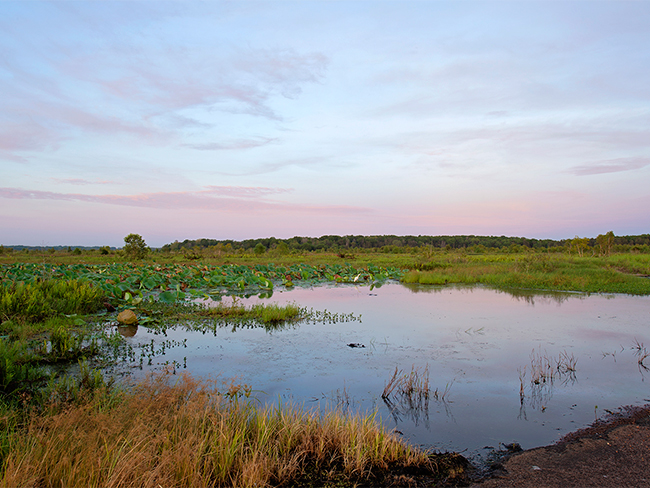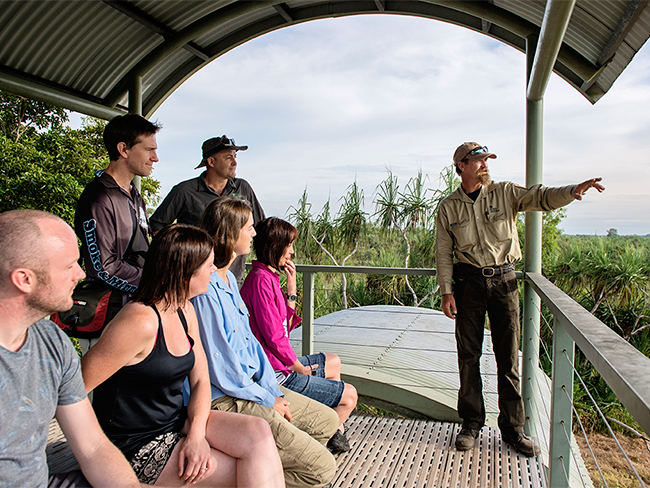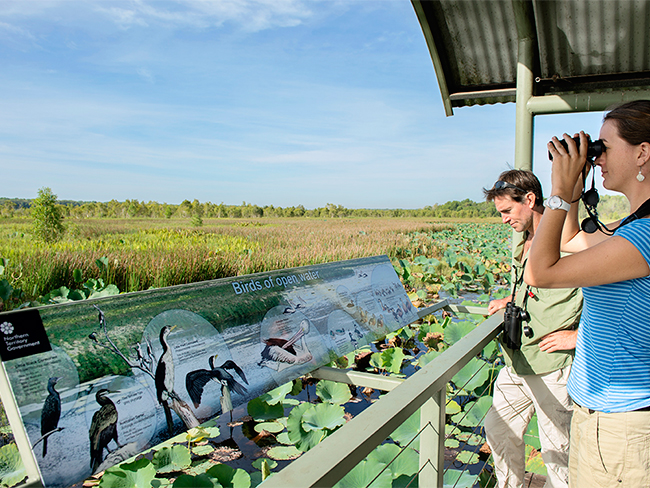Fogg Dam Conservation Reserve
Fogg Dam Conservation Reserve is only a 45-minute drive from Darwin.
It is one of the most accessible places in the Northern Territory (NT) to experience spectacular wetlands and wildlife throughout the year.
If you're a keen bird watcher, there are often a variety of birds around the dam wall.
It is also a haven for water pythons, freshwater turtles and other wildlife.
Fogg Dam has one of the world's highest biomass of predator (water pythons) to prey (dusky rats) ratio. They make their homes in the cracked mud during the hot Dry Season from August to October, while waiting for the rains.
There are several walks through monsoon and floodplain habitats.
If your time is limited, don't miss visiting the bird hides on the dam wall or Pandanus Knoll Lookout, which looks over the wetlands and is spectacular at sunrise and sunset.
Fogg Dam is located on the traditional lands of the Limilngan-Wulna people, who are active in the reserve's management.
This park requires visitors to the NT to have a parks pass.
Get the:
For more information about site access, phone 08 8999 4555.
| Park sites | Status | Comments | Forecast opening |
|---|---|---|---|
| Fogg Dam Conservation Reserve | Open | ||
| Monsoon Walk | Open | ||
| Woodlands to Water Lilies Walk | Open | ||
| Dam Wall | Open |
All year round.
From December to July the water lilies and other plants are in bloom.
Fogg Dam is the only wetland in the NT you can get to all year round without a four-wheel drive. It is only an hour's drive from Darwin on sealed road.
Travel 60km south along the Stuart and Arnhem Highways from Darwin. Turn left on to Anzac Parade and travel for 10km to the reserve.
You can do all of the following activities in the reserve:
- wildlife watching
- birdwatching - see below
- photography
- walking tracks
- ranger-guided activities.
Nearly 200 different bird species have been found in the Fogg Dam area.
Many of these are rare, hard to find elsewhere, or are considered attractive.
You should take binoculars and a bird field guide if you go there.
It's important not to startle the birds. Don't get too close to them or their nests.
Move slowly and quietly along the trails. Wearing dull-coloured clothing also helps.
When you should go
The season and time of day will effect the number and range of birds you can see.
Time of day
You will see more birds if you start early in the morning.
The hotter middle part of the day is often quiet as birds are resting.
Many come out again later in the afternoon.
You can see waterbirds at any time of day.
Season
You can see a lot of birds migrating from the northern hemisphere in the build-up to the Wet Season.
When the rains start many waterbirds leave for other wetlands to breed.
During the Dry Season birds arrive to escape the winter in other parts of Australia. Waterbirds arrive as other wetlands dry out.
Fogg Dam has all of the following facilities:
- information signs
- public toilets
- disabled access
- picnic area
- bird hides
- scenic lookout platforms
- boardwalks.
When visiting the park, remember all of the following:
- visitors to the NT require a parks pass
- take your rubbish with you or put it in a bin
- stay on marked roads and tracks
- all cultural items and wildlife are protected
- pets are not permitted in the park
- nets, traps and firearms are not permitted
- camping is not permitted
- no fishing
- check your vehicle is not transporting pests like weeds and cane toads.
You can have a safe and comfortable trip to Fogg Dam Conservation Reserve by doing all of the following:
- observe park safety signs
- observe all crocodile warning signs
- carry and drink plenty of water
- wear a shady hat, sunscreen and insect repellent
- protect yourself from tropical disease
- wear suitable clothing and footwear
- carry a first aid kit
- avoid strenuous activity during the heat of the day
- use free interactive park maps on your mobile phone or tablet
- make sure your vehicle is well-maintained and equipped
- beware of theft, lock vehicles and secure valuables.
Phone: 08 8999 4555
Give feedback about this page.
Share this page:
URL copied!


